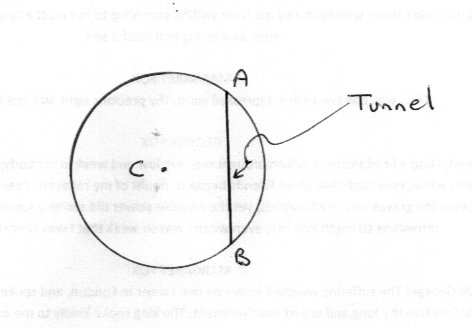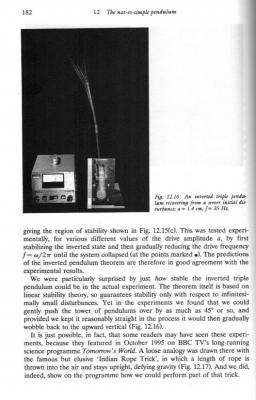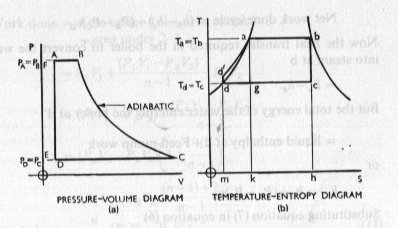-
Posts
18481 -
Joined
-
Last visited
-
Days Won
108
Content Type
Profiles
Forums
Events
Everything posted by studiot
-
A little mechanical analysis (you only need high school mechanics for this) will answer these side questions en route to the answer to the original question.
-
1) 42.5 minutes actually, Douglas Adams got it slightly wrong. 2) That is the question of the puzzle.
-
Sorry I didn't explain it very well but now you also make me feel ashamed as your picture is sooo much better than mine. Interestingly the answer is the same as the key question in the Hitchikers Guide to the Galaxy.
-
This one is a version of a problem due to Lewis Carrol, hence the thread title. A and B are two points on the surface of the Earth which are connected by a straight tunnel. Both A and B are on the same side of the centre of the Earth. Alice rolls a ball into the tunnel at A. How long will it take the ball to reach B, neglecting frictional resistances? Take the radius of the Earth as 4000miles and g = 32 ft/sc2
-
Since I don't know who you are or where you are or what level this is how about Temporary or permanent road construction on unstable (soft or inadequate) ground eg a bog? This should be applicable the world over.
-
OK, I'm glad you understand limits and that you have found Paul's Maths Pages. Paul's Pages are to be recommended. The page you link to is all about manipulation of limits as algebraic entities and a pretty comprehensive list of possible aglebraic operations on one, two or more limits and some constants. You should note something he says at the top of his excellent table. The important bit is 'assume the limits exist'. So here he sets out the conditions when the statements are true. This is very important and often forgotten in applications. It is up to the user to make sure that the usage is suitable for the application. So yes, they are true, subject to that restriction. Two important things you should remember from your understanding of limits. Firstly the fact that a limit of a fucntion at x=a exists does not mean that the function has this value at x=a. Secondly discontinuous functions may have different limits 'from the left' and 'from the right', depending upon which direction you approach the set point.
-
You say you are not a maths student and I'm sure uncool can put you right on the maths. But I am a little concerned by the phrase I'm looking for some identities regarding the 'tends to' part of the limit. A limit is a process and the result of that process. You need both parts of the definition to understand limits. This is simlar to the comment that a function is a process and the result of that process and also includes the 'working material' of the function, called the domain. Hilbert spaces are rather esoteric and advanced for someone who is not a maths student, if you would like to explain you interest it would help couch replies in suitable language.
-
Actually corner reflectors are used, not mirrors, if you want strong reflections.
-
Well yes and no. The Abel-Ruffini theorem refers to polynomials; these are a type of linear equations in linear algebra. In the same way a fourth or nth order linear differential equation can be written in a (linear) polynomial in the D operator eg (aD4 + bD3 + cD2 + dD + e)(x) = 0 : a, b c, d, e are constants; D is the D operator. Has a general solution related to the solution of the fourth order polynomial. Here are lots of pdfs and youtubes on solving linear differential equations by the D operator. https://www.google.co.uk/?gws_rd=ssl#q=operator+method+for+linear+differential+equations But general fourth order differential equations may contain terms that preclude this or may be nonlinear in which case the answer is no.
-

common sense and things that make sense
studiot replied to paragaster's topic in Suggestions, Comments and Support
We used to have two phrases Common sense and Engineering commonsense. and Economics and Engineering economics. Both of these suffer from the same difference. -
Hello, phi perhaps you should contact the man who built the inverted triple pendulum balancer in 1995. It doesn't look too expensive (perhaps a double malt?)
-
I didn't see the December '16 thread referred to in the outset posts, but you have subtitled this thread ' 3 possibilities'. That brings me to an interesting spin off point about this. The coin toss is about the simplest random process we have. We usually accept that we have equal probabilities of 0.5 and 0.5 for each side. If we step up one level of complexity to the standard die of six sides we have equal probabilities for each of six sides. But introducing the die introduces something not available witht the simple coin toss. We can conside the probability of a number less than or equal to 3 (other other combination). This probability is also 0.5. Now that we have understood that we can create new categories of event by combining outcomes we can look again at the coin toss. We can now consider the probability of 'anything else happening at all' This is a very useful step forward as we can now have 3 outcomes Heads, Tails, Anything Else. If we can show that the probability of anything else is below the radar, ie insignificant, we can go safely return to our unbiased coin. Evidence has been presented to suggest that the probability of anything else is less than .0002. Do you think this is significant?
-
Good answer +1 There is one thing about these devices, they are indiscriminate. So it is difficult to be certain what you are pointing them at. You have to be careful the received reflection (OP note not refraction) is actually from the object of interest. This is where dedicated reflector types have the advantage, but obviously you have to be able to access the target.
-
The site is The British Broadcasting Corporation. Much of their output is also available on youtube.
-

Work and energy (split from what is energy)
studiot replied to Roger Dynamic Motion's topic in Classical Physics
Thank you for thinking about my questions, but please reply ouside the quote as it makes copnversation easier and more manageable that way. I'll take your second answer first. No I did not say work was done, you did and I quoted where you said it in my post #8 So I asked you about it. What you say is not wrong it is just not complete, because there is a difference between heat and work. That was why I asked the first question because there are other aspects to energy besides work and heat is one of them. For example energy in the form of heat is added or removed to cause a phase change, but no work is done. This is called the latent heat. Even in the purely mechanical world there is a theorem: "No work is done when a system of forces in equilibrium move their point of application." This is known as the first theorem of Virtual Work and is much used in certain forms of mechanics and as a test for equilibrium. -
There is a series of programmes on BBC television http://www.bbc.co.uk/programmes/b08ghp29 A couple of the cases were very similar to what you are describing, where sense information gets scrambled, some are even more bizare. I don't know what you can access online but Dr Weston's programmes are also available on DVD. Many of the cases were from the US if you are there. Perhaps you can interest a researcher in your friend's case.
-
Was this a serious question or just idle daydreaming? One of the most basic and elementary things we learn in Chemistry is the classification of 'substances' into pure compounds and mixtures. Do you understand this and further what the terms homogeneous and amorphous mean? Analytical Chemistry is a huge branch of the subject so perhaps if you would put some effort into explaining what you really mean someone might be able to help you. +1 to sensei for his guess as to your intentions.
-
Happy book hunting, but be aware that these are older books, (mid 20th century), commensurate with your area of interest and techniques you might have available to you as an amateur.
-
Who says modern science arose in Europe or was kicked off by the renaissance? I suggest that the earliest humans discovered and used the scientific method (better than some here I might add) I further suggest that earlier peoples put it to different uses than the more recent Europeans. And that these uses were conditioned by the times of their use. We just need to recognise the differences. Comparing Neolithic Science and Modern Science, consider a flint arrow head. Modern Man looks at this and sees a 'bulb of percussion' and striking ripples. He sees a certain Moh's hardness and so on. By the time neolithic man was making this arrowhead, he must have already used the scientific method several times. Firstly to be making an arrowhead he must have invented the bow and arrow. So he must have understood enough elasticity from his point of view to have tested different woods for springiness and hides as strings. He would also have previously established that flint is a far better material than say sandstone for the job. That is why modern Man does not dig up sandstone arrowheads. Roll on many tens of thousands of years, and further scientific developments such as the discovery of a marvellous new material for arrowheads. Bronze. By this time population density had increased and Man needed to develop skills in new directions - Social Sciences. He had to learn to live together in significant sized settlements. So much development at that time concerned this aspect of developemental history. Hammurabi's code was a prime example. But all the ancients from then on were hindered from turning down a modern path right up to the pre-renaissance when the 3 centuries between Fibonnaci and Cardano saw the development of the full number palce system - our decimal system. Science needs Mathematics and this is where our version started. Previous mathematics had all been unrelated 'cookbook' techniques, like the instructions for arrow making. Specifically aimed at solving a particular problem or meeting a particular need.
-

Work and energy (split from what is energy)
studiot replied to Roger Dynamic Motion's topic in Classical Physics
Roger, your posts are getting better. I am regrading them from wildly inaccurate to incomplete and a bit confused. Keep the progress up. Two questions for you to think about. Why do you think that, since it was first stated, the First Law of Thermodynamics makes a distinction between work and heat transfer, if all energy involves work? You say that energy is transferred to do work. In what form was energy before it was transferred? -
You might like to seek out this book Electron Physics and Technology by Thomson and Callick (note not JJ Thompson with a p) English Universities Press (So sad they were shut down) Chaper 5 Gaseous conduction is of particular interest. But the whole book is a mine uf useful theoretical and practical information from materials, to pumps to vacuum generators to HV pulse generators. Also very relevant is Advances in High Voltage Insulation and Arc Interruption by Maller and Naidu Pergammon
-
For the benefit of whoever liked my previous post the thing about Thevenin is that it replaces the whole circuit to the left of the load between point A and B with a contant voltage generator in series with a resistor. The purpose of the CV generator is to provide the voltage that is actually applied across AB by the missing (replaced) circuit. The value of this voltage generator is called the Thevenin voltage. The Thevenin voltage is not the voltage across both the CV generator and the series resistor, it is just the value of the CV generator. The purpose of the resistor is to take account the loading effect of the load so in this case Vth is the 8 volts that appears across AB without the load as given by the potential divider ie 4/5 of the 10 volts across the 4k resistor in series with a 1k resistor. In the real real circuit the connection of the load 20k resistor on the right hand side of AB is in parallel with the 4k resistor so it reduce the the actual voltage across AB in the actual complete circuit below 8 volts. Thus Rth is added to provide the Thevenin circuit with the 8 volts divided between Rth and the 20k load. FYI Norton analysis works in exactly the same way except that a constant current generator with a parallel resistor is used.
-

Efficiency: Gas turbine vs. Steam Turbine (with graphics)
studiot replied to Elite Engineer's topic in Engineering
The title of this thread looks like a homework question so I am going to treat it as such. Both gasand steam turbines areheat engines. That is they interconvert between heat and work - in this case they output (useful) work from an input of heat. The thermodynamic efficiency of all heat engines depends mainly upon the temperature difference between the reservoirs. Other measures of efficiency are available such as comapring the energy in the fuel with the output but this is not the thermodynamic efficiency. So your first task must be to decide which efficiency measure you are discussing. Air plus fuel can be heated to a higher temperature than steam so has an inherently higher work generation. Latent heat for steam does not thus enter the calculation. However the gas turbine work also has to power the air compressor which work is then unavailable to output. So you need to look at the cycles for steam and gas turbines - I suspect that is where the diagrams come in and they want you to discuss the differences between the steam cycle and the gas turbine cycle. The Rankine cycle or perhaps the simpler carnot is appropriate to the steam cycle The constant pressure or again perhaps the carnot gas cycle is appropriate for the gas turbine. Here is the sort of diagram I am referring to for thye Rankine cycle.




